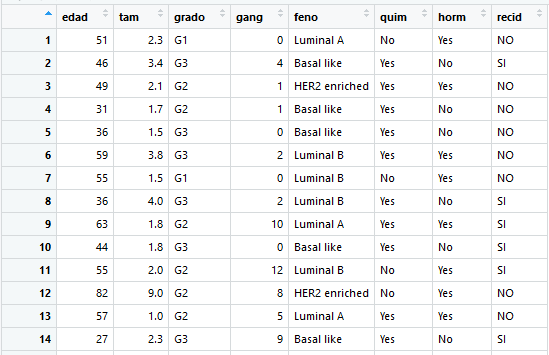Hello!
I need to create a dataset encoded with autoenceders.
I have installed and loaded the following libraries:
library("rminer")
library("keras")
library("tensorflow")
library("reticulate")
I have divided my data set into two parts, training and test, with the holdout method:Datos is my dataset
I get the training and test data, removing the column that is the data that you want to predict:
x_train <- subset(Datos[Division$tr,], select = -recid)
x_test <- subset(Datos[Division$ts,], select = -recid)
Then I convert the data set to matrix (I do not know if this is necessary)
x_train_matrix = data.matrix(x_train)
x_test_matrix = data.matrix(x_test)
At this moment, what I want to do is the following:
Define a coding model, with an input layer and the coding layer.
Extract the encoded data, for later take this reduction of characteristics to use them in other training models
original_dim <- 7L #334L #32L
Am I on the right path?
I need help to achieve the goal I have tried to explain, I hope you help me.
Am I correct that what you intend to do is in the line of what @max describes in his book
https://bookdown.org/max/FES/engineering-numeric-predictors.html#autoencoders
?
that is - some kind of semi-supervised feature extraction to use on structurally identical datasets?
In general, a good introduction to how autoencoders work (with code in Python, but it should look pretty similar in R) is
https://blog.keras.io/building-autoencoders-in-keras.html
(In your case, probably the first two models - simple and sparse autoencoder) would apply.)
Regarding the code snippets, some comments
You will want to have a "bottleneck layer" "in the middle" and then an output layer of the same dimensionality as the input
The categorical data needs to be one-hot encoded
With a mix of categorical and continuous variables, it can be difficult to find an adequate loss function - mean squared error will probably work best
For better performance, standardize the numerical variables
Hope this gets you started
Thanks, I'm trying to do the following, but I do not know if I'm right
# read de dataset
Datos <- read.table(file="datos_campus_virtual.txt",header=TRUE)
# conver to categorical data
for(unique_value in unique(Datos$feno)){
Datos[paste("feno", unique_value, sep = ".")] <- ifelse(Datos$feno == unique_value, 1, 0)
}
for(unique_value in unique(Datos$grado)){
Datos[paste("grado", unique_value, sep = ".")] <- ifelse(Datos$grado == unique_value, 1, 0)
}
Datos$quim <- ifelse(Datos$quim=="No",0,1)
Datos$horm <- ifelse(Datos$horm=="No",0,1)
Datos$recid <- ifelse(Datos$recid=="No",0,1)
# Two set: training (334) y test (166) with holdout
Division <- holdout(y=Datos$recid)
# prepara de data training and test
train <- Datos[Division$tr,]
x_train <- subset.data.frame(train,select = -grado)
x_train <- subset.data.frame(x_train,select = -feno)
test <- Datos[Division$ts,]
x_test <- subset.data.frame(test,select = -grado)
x_test <- subset.data.frame(x_test,select = -feno)
x_train_matrix = data.matrix(x_train)
x_test_matrix = data.matrix(x_test)
# Autoencoder and encoder
original_dim <- 15 #7L
encoding_dim <- 7 #4L
latent_dim <-15 #7L
# **********************
# Model definition
# **********************
# this is our input placeholder
input <- layer_input(shape = c(original_dim))
# "encoded" is the encoded representation of the input
encoded<- layer_dense(input,encoding_dim , activation = "relu")
#decode layer
decoded<- layer_dense(encoded, latent_dim , activation = "sigmoid")
model_enconded <- keras_model(input, encoded)
model_autoencoder <- keras_model(input, decoded)
# **********************
# Compile
# **********************
model_autoencoder %>% compile(optimizer = 'adadelta', loss = 'binary_crossentropy')
# **********************
# training
# **********************
history <- model_autoencoder %>% fit(x_train_matrix, x_train_matrix,epochs=50,batch_size=256)
#predict
feature <- predict(object = model_enconded,x = x_test_matrix)
# Save de new data
write.csv(feature, file = "dataencoded.csv",row.names = FALSE)
Max
July 18, 2018, 7:38pm
4
There's a better workflow example given as an example here . I would avoid using data.table if you are going to put the data into a model; most model functions don't work with them based on how they store the data.
Also, having a small reproducible example is the main way for people to check/verify your code. Otherwise, it's all guesswork on our part.

